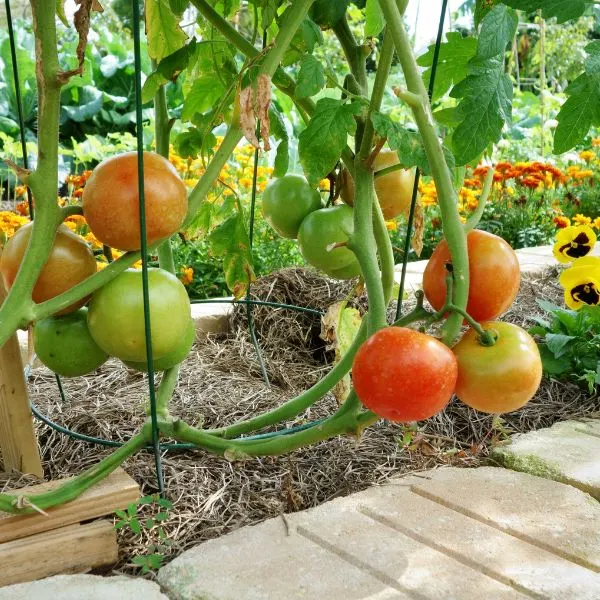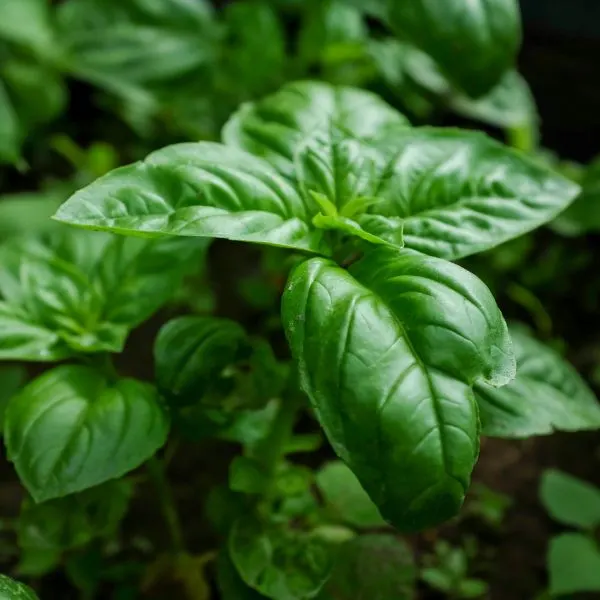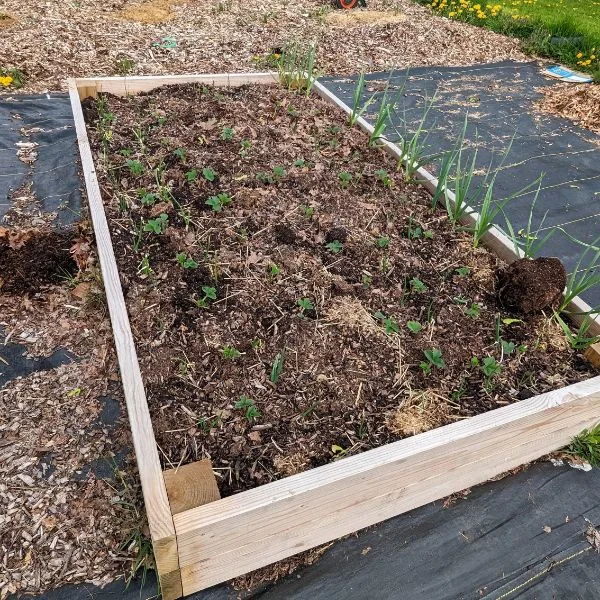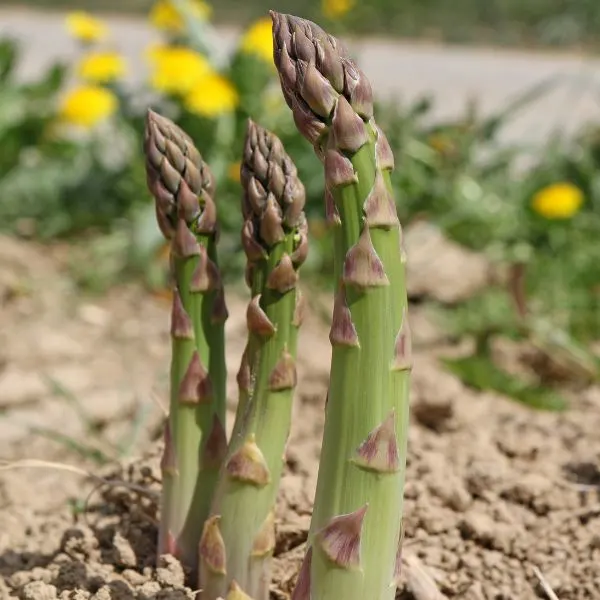Are you considering planting a tomato garden? Congratulations — There’s nothing quite like fresh tomatoes! If you’re planning on growing a good volume, however, it’s going to take some planning. So, how far apart should tomatoes be planted in order to keep them healthy and ensure that they bear the most fruit?
For best results, your tomatoes should be planted 18 – 24 inches apart and you should also make sure that rows are spaced 3 – 4 feet apart. This helps to keep them from fighting over resources, reduces the chances of them sharing diseases, and it also gives you plenty of room to work with for pruning and harvest time.
That 18 – 24 inch range is a little ‘general’, however, as the actual number of inches will depend in part on what types of tomatoes you are planting and where you are planting them.
In order to give you the best answer, today we’ll explore how far apart tomatoes should be planted and we’ll also cover companion planting options, the ‘basketweaving’ trellis strategy, and give you some general tips to give your tomatoes a fighting edge.
Let’s talk about tomato spacing and planning the perfect tomato garden!
Table of Contents
Why do I need to properly space my tomatoes?

While it takes a little extra time and planning to organize your tomato planting, it’s definitely worth the effort. Below we’ve listed some of the main perks to give you an idea of what you’ll be getting in return for your thoughtful garden planning:
Spacing ensures adequate sunlight – While you should get SOME tomatoes with 6 hours of sunlight, you really want to target a minimum of 8 hours or more for best results. Tomato plants love sunlight and so this is going to be a critical factor. By spacing your tomatoes properly, they won’t spend extra energy racing their vines higher just to get a little more light and they can put all their efforts towards fruiting.
Disease spreads easier with crowded tomatoes – Just like with people, crowding makes disease transfer much, much easier. While spacing your tomatoes won’t guarantee that one sick plant won’t infect the others, it definitely raises your chances of spotting a problem and quarantining or treating the affected plant before a disease can spread!
It gives you space to work – If you plant your tomatoes in neat little rows, each plant separated 18-24 inches apart, and each row spaced 3 – 4 feet apart, then you have plenty of room to prune your plants, fertilize them, treat any sick plants, and to harvest them when the time is right. Just
Your tomatoes won’t fight over resources – Tomato plants are very heavy eaters. They need a lot of nutrients in order to produce those delicious tomatoes and if they are too close together, then the plants are going to fight over resources. By properly spacing them, you can control the nutrient flow and your tomatoes will only ‘eat from their own plates’.
Proper spacing gives you companion planting options – Some plants may be grown close to tomatoes and not only will they not fight over resources, but they can do things like keep weeds away, repel tomato worms, and provide other quirks that can greatly benefit your crop. It’s optional, of course, but proper spacing gives you this option if you would like to try companion planting.
Now that we’ve talked about why proper spacing is so important, let’s get into some more exact numbers as far as your spacing. It’s really going to boil down to ‘what type of tomato are you growing?’ and “where are you growing it?”, so let’s explore that and you can see what we mean!
What type of tomatoes are you growing?
The right amount of space to put between your tomatoes is going to depend on what type of tomatoes you are growing. In order to help you in your planning, let’s compare the types of tomatoes so that you can have a better idea what to factor in for your calculations.
Determinate
With determinate tomatoes, you are dealing with a plant that’s going to grow to an approximate height and then STOP at that height, spreading out a bit like a bush. For these types of tomatoes, a 24 inch space is going to be ideal, unless you are dealing with a dwarf species.
For dwarf tomatoes, the spacing can be 18 inches, but to be clear when we say ‘dwarf tomatoes’ we are talking about the smallest varieties that grow to be 12 to 24 inches tall, such as the Tiny Tim, Patio Choice Yellow, and Fantastico varieties. If your dwarf variety grows to be taller than 2 feet, then go ahead and space them 24 inches apart for best results.
Indeterminate
Indeterminate tomato plants are climbers, and so their constant ascension makes them a little ‘skinnier’ than the bushier determinate varieties. As such, you COULD space them 18 inches apart, but we would really recommend giving them 24 inches of space so that you can really manage their resources well and ensure that they are getting all the sunlight and nutrients that they can handle.
One exception to this spacing rule is unstaked indeterminate tomatoes. Some gardeners like to just let their tomatoes grow as they may, without a trellis or a makeshift support, and if you prefer that method you need to space them 3 to 4 feet apart in order to accommodate their larger width.
Where are you growing your tomatoes?
The second factor that will determine proper spacing is going to be the location where you are growing your tomatoes. Let’s break that down into the 3 most common options:
- Standard garden planting – If you’ll just be making a spot on the flat ground to plant seeds or transplant seedlings, then rows separated 3 feet apart and plants 24 inches apart will be the ideal configuration. If you don’t like rows, stick with 24 inches of separation, but consider organizing them – if they are difficult to get to, it’s a pain during harvest time, and remember that indeterminate tomatoes need a lot of pruning. You’ll be glad for that space, if you make it!
- Raised bed tomatoes – In raised beds, you can separate your tomato plants 18 – 24 inches apart and get excellent results, although 24 inches is what we would recommend if you can afford the extra space. If you will be working with more than 12 inches of soil depth, however, you can probably get away with spacing them 15 inches apart but you’ll need to keep a close eye on them. While they won’t fight over resources with a deep bed like that, if one plant gets sick you could be in a lot of trouble!
- Container-bound tomatoes – While it’s tempting to grow more than one plant in a 24 x 24 container, we don’t recommend it. Tomatoes need a LOT of resources, although you can certainly plant something that won’t compete like a nice bit of lettuce!
Consider a Basketweave trellis if you are growing a lot of tomatoes
If you LOVE tomatoes and intend to grow quite a lot of them, then you can save yourself a good bit of money on wire trellising and also organize your rows nicely with a little technique called a ‘basketweaving’. We’ll outline the steps here so that you can get a nice mental image of the technique – we think you’ll like it!
What you’ll need:
- Wooden trellis posts or Steel ‘T’ posts
- Strong thread
Steps to Basketweave:
- Going through your plant rows, you’ll need to drive your steel or wooden trellis post every 3 to 5 plants along the line of your row.
- Starting low, tie your thread to the end post and weave it through your plants, circling each post for added support or simply pulling it taut from end to end. Your young tomatoes can ’lean’ on the first string for support for now and you have a very basic string-trellis.
- As your tomatoes grow, you will thread a new string but do it in such a way that you are supporting the opposite side.
This method of trellising saves you money on expensive wire cages and if you sometimes miss some garden time, then when you go out to ‘catch up’ you can quickly weave a new string into your Basketweave trellis and give your tomatoes the support that they need in minutes. This particular method will only work with straight rows, so it’s another one of those perks that you can get from organizing your tomatoes, but if you’ve never tried basketweaving then we’d highly recommend it. It’s a cool little garden hack that helps your tomatoes to soar.
Just be sure that your post goes high enough – find out how high your tomato variety can grow and then plan accordingly, just to make sure that you don’t run out of vertical space!
Companion planting for extra perks
Since you will be spacing your tomatoes, it might interest you to know that you can accomplish some very useful things through the simple art of companion planting. By choosing companion plants for your tomatoes that won’t fight over resources, you can gain useful perks like natural pest repellent properties, improved flavor, nitrogen boosts, and more!
While we don’t have time to cover this subject in depth, we can give you a few examples of excellent companion plants for your tomatoes that can help you to fill in that space to keep out weeds and to harvest a few benefits that your tomato plants wouldn’t have on their own.
Basil

Basil is a great companion planting option for your tomatoes. For one thing, it repels a large number of pests, such as mosquitoes, white flies, carrot flies, asparagus beetles, and tomato hornworms! It will also pull double-duty by attracting pollinators, such as bees and butterflies. You can plant it as close as 15 inches to your tomatoes and it won’t fight with them over resources, but it will provide a solid bit of defense and some even believe that Basil will increase your yield!
While that last bit might be an ‘old gardener’s tale’, the repellant and pollinator-attracting properties definitely hold, so consider companion planting Basil with your tomatoes – you’ll be happy that you did!
Garlic

Garlic is not only delicious with tomatoes anyway, but in the garden they are the best of buddies, too! Plant it in the central space on your walking row between your tomato plants and it can repel pests like root maggots, codling moths, snails, and spider mites. Also, as a protip, if you plant your garlic 1 month before you harvest your tomatoes, they’ll both be ready to pick at the same time!
Asparagus

Asparagus and tomatoes make excellent companions, as they can both have an effect on pests that plague the other. Tomatoes, for instance, will repel asparagus beetles, which is a nice little perk already, but asparagus will repel root nematodes that might otherwise get your tomatoes, so it’s a great deal for both of them.
Space them about 15 inches or simply ‘pepper’ the center portion of the walking row so that they are between the tomato plants on your walkway. They’re easy to navigate around and you’ll get some pretty solid benefits out of the pairing.
Some quick tips for tomato garden planning
Now that you know what kind of spacing your tomatoes are going to need, we thought we’d share a few quick tips to keep in mind before you start measuring out your area and planting. Here are a few quick tips that can help to ensure a successful tomato garden:
- Select disease-resistant seeds – Check for disease resistant varieties of tomatoes. For instance, ‘Better Boy’ tomatoes have a high resistance to fusarium and verticillium wilt, but that’s just one example – see what they’ve got at your local nursery. It’s definitely worth it!
- Propagate your seeds in advance – You can propagate your seedlings in an egg carton in advance and then transplant them when they’re big enough and your garden is good and ready. You don’t have to do this, but it’s a great way to start off strong.
- Indeterminate tomatoes need regular pruning – You need to pinch off those suckers regularly with indeterminate tomatoes, otherwise you’ll get a disappointing yield, so don’t forget to check regularly to see if your tomatoes can use a helping hand. They’ll pay you back plenty come harvest time!
- Use the right fertilizer – A good tomato fertilizer with an NPK of 8-32-16 or 12-24-12 is going to be ideal. You will want to fertilize once at planting, once after the appearance of your first tomato, and a final time after harvesting the first fruits.
FAQs
It’s time for us to start wrapping things up, but before we formally bid you adieu we have collected some frequently asked questions to cover any bits that we might have missed along the way. Let’s take a look and then we’ll get to formally ‘closing up shop’!
What is the effect of spacing on tomatoes?
Spacing your tomatoes helps to prevent the spread of disease by providing excellent air circulation, and it also helps to ensure that your tomatoes get enough sunlight and nutrients without having to fight for it. Finally, spacing helps to ensure a larger, higher-quality yield, while making your tomatoes much easier to harvest when they are fruiting.
What is the best space in inches for separating tomatoes?
While 18 to 24 inches is the recommended spacing, sticking with 24 inches of space between your tomatoes is ideal if you can do it. This gives them plenty of room so that you needn’t worry about resource fighting or diseases spreading too quickly before you can quarantine the sick plant.
Will my tomatoes be stunted if they are too close together?
Yes, if tomatoes are planted too close together, then they start fighting over the available resources and might even expend extra energy trying to outgrow one another to get the most sunlight. The end result is usually going to be one, if not both of your plants coming out stunted or at the very least, bearing very little in the way of fruit.
Some closing words
Today we’ve answered the question ‘how far apart should tomatoes be planted?’ and while the answer is ’18 to 24 inches’, it will vary based on the type of tomatoes and where you are planting them. In most cases, if you go with 24 inches of separation, that will be just about perfect, but if you are planting dwarf species or using a particularly deep raised bed, then you can certainly plant them closer to each other.
Just keep in mind that if you DO plant them closer together, then if one of your plants becomes sick you might have to move very fast to contain the issue – so it might not be worth it just to pack in a few extra plants.
So, plan accordingly and space your tomatoes well, and with a little luck you’ll soon be enjoying an amazing and delicious harvest. As always, thanks so much for visiting us, and we sure hope to see you again soon!
More tomato plant guides
